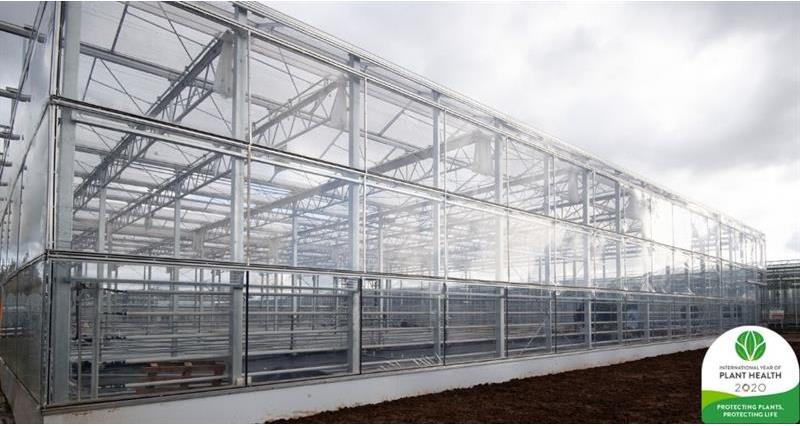The Natural Light Growing Centre, at Warwick University's Innovation Campus will act as an experiment and demonstration facility to investigate the benefits of full spectrum indoor growing.
RIPE use an innovative construction technique that makes building an ETFE greenhouse quick and easy. RIPE has developed a new heat process using a specific IR frequency to tension the ETFE film over the structure's frame. If the ETFE is later deformed by weather conditions such as snow or hail, the film can simply be heated back up and re-tensioned, using RIPE's patent-pending technology.
Why use ETFE?
ETFE (ethylene tetrafluoroethylene) is a unique film with similar light transmission to current best practise glasshouse glazing, however needs less structural support allowing for greater light ingress. The ETFE film is more resilient to severe weather conditions than glass; if a glasshouse is damaged by hail then the glass may shatter, ruining a whole crop. In the case of ETFE film, a small, repairable hole would be the equivalent damage, with no effect on the crop. Additionally, ETFE film is recyclable and reusable!
Unlike glasshouses, there is no break in the film at the glazing bars, resulting in reduced heat and CO2 loss.
The ETFE film being used at the Natural Light Growing Centre has been developed by RIPE and 3M to include an 'advanced plasma etched nano-surface treatment' - this provides the material with highly anti-drip properties that will last the lifetime of the film.
What is the science behind full spectrum growing?
Glass filters out UV light, so plants grown under glass are not exposed to the UVA and UVB radiation that they naturally would be if grown outside. ETFE transmits the full spectrum of light, meaning that plants grown in an ETFE greenhouse benefit from the UV radiation present in natural light. Therefore, growing under ETFE allows for a controlled physical environment with full natural light, whilst minimising the adverse effects of weather on production systems.
Exposure to the full spectrum of light allows all of the chemical pathways that have evolved in a particular plant variety to be stimulated. Exposure to UV light in particular, activates the plant to produce certain chemicals (phenols, terpenes and flavonoids) that act as its 'sunscreen'. These chemicals impact the flavour, aroma and colour of the plant. As an example, anthocyanin is a chemical enhanced by UV exposure and is responsible for reddening the tips of lettuce leaves.
These activated chemicals are also responsible for repairing any UVA/UVB damage to the plant, improving hardiness and shelf life. Stronger plants can withstand lower temperatures, i.e. allowing production later into the autumn/winter without needing to heat the greenhouse, as well as being able to withstand higher temperatures in the summer before needing to vent the structure. This results in reduced energy consumption and CO2 loss.
Philip Lee, Managing Director of RIPE Building Services:
“There are numerous papers showing how UV light has a significant impact on secondary metabolite production, such as taste in tomatoes and brightness in flowers. However, this is not simply about 'adding in' UV. There is so much more we need to do to understand light interactions and circadian rhythms in plants, as well as the microbial and macrobial interactions with plants in soils.
RIPE is about developing naturally enhanced, biomimicry production, by learning as many tricks as we can from nature. We start with the most important element we can bring, natural daylight, before moving to micronutrients, biostimulants and biologically active substrates.
It’s time to get back to basics and break the glass ceiling, so to speak.
In terms of sustainability, there shouldn't be an AD plant in the country without some form of operation alongside it growing new, bespoke crops. The industry welcomes a new, younger generation of growers exploring their own ideas and markets; it’s time for horticulture to get reinvigorated again.”
What else is happening at the Natural Light Growing Centre?
Another area of research that CHAP will focus on at the facility will be nutrient circularity. Researchers intend to look at the nutrient life cycle across the whole of the controlled growing system, in order to develop new ways to recycle nutrients and introduce recycled nutrients from other sources. The aim is to be able to use fewer nutrients, in an optimised way.
